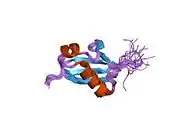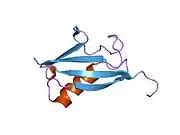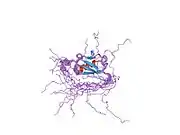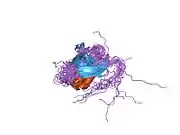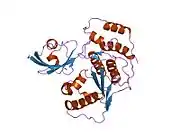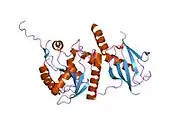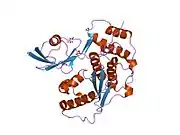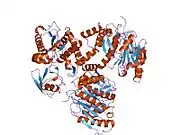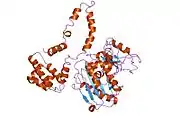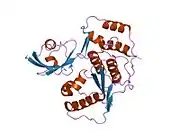SUMO2
Small ubiquitin-related modifier 2 is a protein that in humans is encoded by the SUMO2 gene.[5]
| SUMO2 | |||||||||||||||||||||||||||||||||||||||||||||||||||
|---|---|---|---|---|---|---|---|---|---|---|---|---|---|---|---|---|---|---|---|---|---|---|---|---|---|---|---|---|---|---|---|---|---|---|---|---|---|---|---|---|---|---|---|---|---|---|---|---|---|---|---|
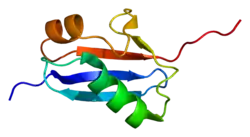 | |||||||||||||||||||||||||||||||||||||||||||||||||||
| |||||||||||||||||||||||||||||||||||||||||||||||||||
| Identifiers | |||||||||||||||||||||||||||||||||||||||||||||||||||
| Aliases | SUMO2, HSMT3, SMT3B, SMT3H2, SUMO3, Smt3A, small ubiquitin-like modifier 2, small ubiquitin like modifier 2 | ||||||||||||||||||||||||||||||||||||||||||||||||||
| External IDs | OMIM: 603042 MGI: 2158813 HomoloGene: 87858 GeneCards: SUMO2 | ||||||||||||||||||||||||||||||||||||||||||||||||||
| |||||||||||||||||||||||||||||||||||||||||||||||||||
| |||||||||||||||||||||||||||||||||||||||||||||||||||
| |||||||||||||||||||||||||||||||||||||||||||||||||||
| |||||||||||||||||||||||||||||||||||||||||||||||||||
| |||||||||||||||||||||||||||||||||||||||||||||||||||
| Wikidata | |||||||||||||||||||||||||||||||||||||||||||||||||||
| |||||||||||||||||||||||||||||||||||||||||||||||||||
Function
This gene encodes a protein that is a member of the SUMO (small ubiquitin-like modifier) protein family. It is a ubiquitin-like protein and functions in a manner similar to ubiquitin in that it is bound to target proteins as part of a post-translational modification system. However, unlike ubiquitin, which is primarily associated with targeting proteins for proteasomal degradation, SUMO2 is involved in a variety of cellular processes, such as nuclear transport, transcriptional regulation, apoptosis, and protein stability. It is not active until the last two amino acids of the carboxy-terminus have been cleaved off. Numerous pseudogenes have been reported for this gene. Alternate transcriptional splice variants encoding different isoforms have been characterized.[6]
Clinical significance
Deep hypothermia protects the brain from ischemic injury, which is why it's employed for major cardiovascular procedures that necessitate cardiopulmonary bypass and a period of circulatory arrest. With an experiment [9] conducted to moderate hypothermia, small ubiquitin-like modifier (SUMO1-3) conjugation was significantly activated in the brain. The effects of hypothermia on SUMO conjugation were evaluated in this experiment[9] using Western blot and immunohistochemistry in animals that were either normothermic (37 °C) or deep to moderate (18 °C, 24 °C, 30 °C) hypothermic cardiopulmonary bypass. In these cells, even 30 °C hypothermia was enough to significantly boost SUMO2/3-conjugated protein levels and nucleus accumulation. Deep hypothermia caused the SUMO-conjugating enzyme Ubc9 to translocate to the nucleus, implying that the increase in nuclear levels of SUMO2/3-conjugated proteins seen in hypothermic animals' brains is an active process. Deep hypothermia caused only a small increase in the amounts of SUMO2/3-conjugated proteins in primary neuronal cells. This shows that neurons in vivo have a greater capacity to activate this endogenous possibly neuroprotective mechanism when exposed to hypothermia than neurons in vitro. Identifying proteins that are SUMO2/3 conjugated during hypothermia could aid in the development of new preventive and therapeutic therapies to make neurons more resistant to a transient blood supply interruption.
References
- GRCh38: Ensembl release 89: ENSG00000188612 - Ensembl, May 2017
- GRCm38: Ensembl release 89: ENSMUSG00000020738 - Ensembl, May 2017
- "Human PubMed Reference:". National Center for Biotechnology Information, U.S. National Library of Medicine.
- "Mouse PubMed Reference:". National Center for Biotechnology Information, U.S. National Library of Medicine.
- Mannen H, Tseng HM, Cho CL, Li SS (May 1996). "Cloning and expression of human homolog HSMT3 to yeast SMT3 suppressor of MIF2 mutations in a centromere protein gene". Biochemical and Biophysical Research Communications. 222 (1): 178–80. doi:10.1006/bbrc.1996.0717. PMID 8630065.
- "Entrez Gene: SUMO2 SMT3 suppressor of mif two 3 homolog 2 (S. cerevisiae)".
- Dai KS, Liew CC (Jun 2001). "A novel human striated muscle RING zinc finger protein, SMRZ, interacts with SMT3b via its RING domain". The Journal of Biological Chemistry. 276 (26): 23992–9. doi:10.1074/jbc.M011208200. PMID 11283016.
- Golebiowski F, Matic I, Tatham MH, Cole C, Yin Y, Nakamura A, Cox J, Barton GJ, Mann M, Hay RT (2009). "System-wide changes to SUMO modifications in response to heat shock". Science Signaling. 2 (72): ra24. doi:10.1126/scisignal.2000282. PMID 19471022. S2CID 33450256.
- Wang, Liangli; Ma, Qing; Yang, Wei; Mackensen, G. Burkhard; Paschen, Wulf (November 2012). "Moderate hypothermia induces marked increase in levels and nuclear accumulation of SUMO2/3-conjugated proteins in neurons". Journal of Neurochemistry. 123 (3): 349–359. doi:10.1111/j.1471-4159.2012.07916.x. PMC 3466336. PMID 22891650.
Further reading
- Maruyama K, Sugano S (Jan 1994). "Oligo-capping: a simple method to replace the cap structure of eukaryotic mRNAs with oligoribonucleotides". Gene. 138 (1–2): 171–4. doi:10.1016/0378-1119(94)90802-8. PMID 8125298.
- Lapenta V, Chiurazzi P, van der Spek P, Pizzuti A, Hanaoka F, Brahe C (Mar 1997). "SMT3A, a human homologue of the S. cerevisiae SMT3 gene, maps to chromosome 21qter and defines a novel gene family". Genomics. 40 (2): 362–6. doi:10.1006/geno.1996.4556. PMID 9119407.
- Suzuki Y, Yoshitomo-Nakagawa K, Maruyama K, Suyama A, Sugano S (Oct 1997). "Construction and characterization of a full length-enriched and a 5'-end-enriched cDNA library". Gene. 200 (1–2): 149–56. doi:10.1016/S0378-1119(97)00411-3. PMID 9373149.
- Kamitani T, Nguyen HP, Kito K, Fukuda-Kamitani T, Yeh ET (Feb 1998). "Covalent modification of PML by the sentrin family of ubiquitin-like proteins". The Journal of Biological Chemistry. 273 (6): 3117–20. doi:10.1074/jbc.273.6.3117. PMID 9452416.
- Kamitani T, Kito K, Nguyen HP, Fukuda-Kamitani T, Yeh ET (May 1998). "Characterization of a second member of the sentrin family of ubiquitin-like proteins". The Journal of Biological Chemistry. 273 (18): 11349–53. doi:10.1074/jbc.273.18.11349. PMID 9556629.
- Saitoh H, Hinchey J (Mar 2000). "Functional heterogeneity of small ubiquitin-related protein modifiers SUMO-1 versus SUMO-2/3". The Journal of Biological Chemistry. 275 (9): 6252–8. doi:10.1074/jbc.275.9.6252. PMID 10692421.
- Nishida T, Tanaka H, Yasuda H (Nov 2000). "A novel mammalian Smt3-specific isopeptidase 1 (SMT3IP1) localized in the nucleolus at interphase". European Journal of Biochemistry. 267 (21): 6423–7. doi:10.1046/j.1432-1327.2000.01729.x. PMID 11029585.
- Dai KS, Liew CC (Jun 2001). "A novel human striated muscle RING zinc finger protein, SMRZ, interacts with SMT3b via its RING domain". The Journal of Biological Chemistry. 276 (26): 23992–9. doi:10.1074/jbc.M011208200. PMID 11283016.
- Tatham MH, Jaffray E, Vaughan OA, Desterro JM, Botting CH, Naismith JH, Hay RT (Sep 2001). "Polymeric chains of SUMO-2 and SUMO-3 are conjugated to protein substrates by SAE1/SAE2 and Ubc9". The Journal of Biological Chemistry. 276 (38): 35368–74. doi:10.1074/jbc.M104214200. PMID 11451954.
- Nishida T, Kaneko F, Kitagawa M, Yasuda H (Oct 2001). "Characterization of a novel mammalian SUMO-1/Smt3-specific isopeptidase, a homologue of rat axam, which is an axin-binding protein promoting beta-catenin degradation". The Journal of Biological Chemistry. 276 (42): 39060–6. doi:10.1074/jbc.M103955200. PMID 11489887.
- Hardeland U, Steinacher R, Jiricny J, Schär P (Mar 2002). "Modification of the human thymine-DNA glycosylase by ubiquitin-like proteins facilitates enzymatic turnover". The EMBO Journal. 21 (6): 1456–64. doi:10.1093/emboj/21.6.1456. PMC 125358. PMID 11889051.
- Kim J, Cantwell CA, Johnson PF, Pfarr CM, Williams SC (Oct 2002). "Transcriptional activity of CCAAT/enhancer-binding proteins is controlled by a conserved inhibitory domain that is a target for sumoylation". The Journal of Biological Chemistry. 277 (41): 38037–44. doi:10.1074/jbc.M207235200. PMID 12161447.
- Su HL, Li SS (Aug 2002). "Molecular features of human ubiquitin-like SUMO genes and their encoded proteins". Gene. 296 (1–2): 65–73. doi:10.1016/S0378-1119(02)00843-0. PMID 12383504.
- Petrie K, Guidez F, Howell L, Healy L, Waxman S, Greaves M, Zelent A (May 2003). "The histone deacetylase 9 gene encodes multiple protein isoforms". The Journal of Biological Chemistry. 278 (18): 16059–72. doi:10.1074/jbc.M212935200. PMID 12590135.
- Hietakangas V, Ahlskog JK, Jakobsson AM, Hellesuo M, Sahlberg NM, Holmberg CI, Mikhailov A, Palvimo JJ, Pirkkala L, Sistonen L (Apr 2003). "Phosphorylation of serine 303 is a prerequisite for the stress-inducible SUMO modification of heat shock factor 1". Molecular and Cellular Biology. 23 (8): 2953–68. doi:10.1128/MCB.23.8.2953-2968.2003. PMC 152542. PMID 12665592.
- Eaton EM, Sealy L (Aug 2003). "Modification of CCAAT/enhancer-binding protein-beta by the small ubiquitin-like modifier (SUMO) family members, SUMO-2 and SUMO-3". The Journal of Biological Chemistry. 278 (35): 33416–21. doi:10.1074/jbc.M305680200. PMID 12810706.
- Tatham MH, Kim S, Yu B, Jaffray E, Song J, Zheng J, Rodriguez MS, Hay RT, Chen Y (Aug 2003). "Role of an N-terminal site of Ubc9 in SUMO-1, -2, and -3 binding and conjugation". Biochemistry. 42 (33): 9959–69. doi:10.1021/bi0345283. PMID 12924945.
- Chung TL, Hsiao HH, Yeh YY, Shia HL, Chen YL, Liang PH, Wang AH, Khoo KH, Shoei-Lung Li S (Sep 2004). "In vitro modification of human centromere protein CENP-C fragments by small ubiquitin-like modifier (SUMO) protein: definitive identification of the modification sites by tandem mass spectrometry analysis of the isopeptides". The Journal of Biological Chemistry. 279 (38): 39653–62. doi:10.1074/jbc.M405637200. PMID 15272016.




